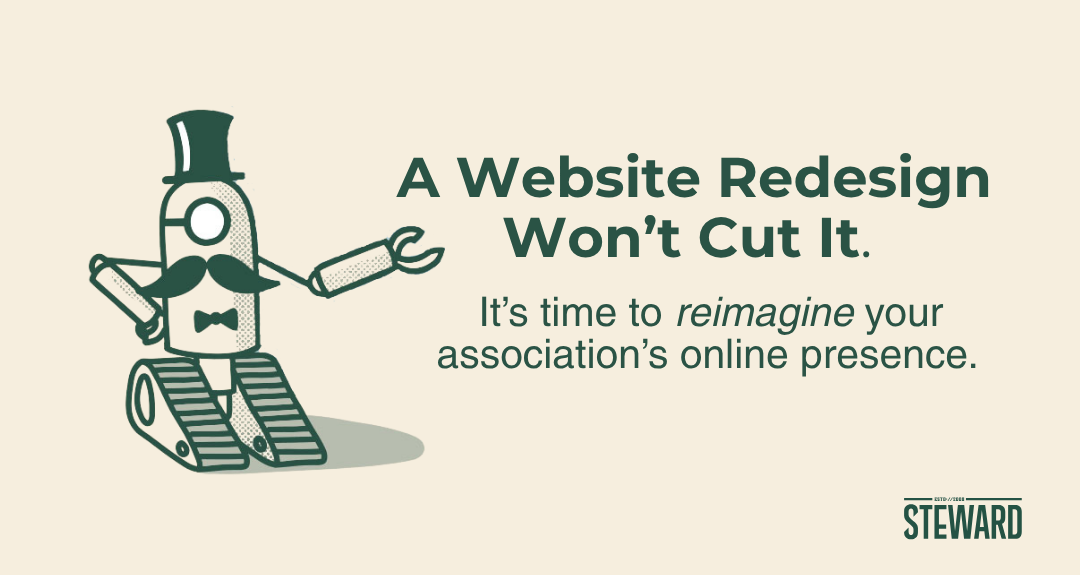
“Redesign” sounds like new fonts, a fresher hero image, some new content, and a cleaned-up nav.
That’s not the job anymore.
Members expect answers, not just more pages, PDFs and forms to fill out.
Staff need systems that work with them, not around them.
AI has changed how people find and evaluate information.
Trust is either reinforced with every click…or quietly eroded.
If you’re planning a 2026 website project, you’ve got to think beyond “redesign.”
How? Read on.
Trust is The Goal
Without trust, design is simply decoration. In 2026, trust shows up as:
- Predictable, fast experiences. Sub-two-second page loads. Clean, accessible patterns your members recognize and can navigate without thinking.
- Sourced content. Clear authorship, dates, citations, and version history. If AI summarizes or suggests, it should point to the exact source.
- Privacy by default. Transparent data practices, consent that’s easy to understand, and personalization that respects member choice.
- Accessibility is table stakes. Make sure you’ve got WCAG compliance, keyboard-friendly functions, proper color contrast, transcripts and captions everywhere.
- Operational continuity. Uptime, backups, SLAs, and a governance plan. Not sexy, but vital.
Trust is not a banner; it’s a cultural pillar.
“AI for Sure”, But with Guardrails
For associations, “AI for sure” means that it’s got to show up somewhere. But where? How?
- Answers across your library. You can set up functionality that can pull content from PDFs, slide decks, meeting minutes, and microsites and then cite the source. This is vital for good GEO.
- Contextual guidance. “Next step” guidance based on where a member is and what they’re trying to do, whether it’s join, renew, register, or learn.
- Summaries that cite. TL;DRs for long pages and policies with a link back to the exact section for verification.
- Multilingual support. Quality translations for key content, reviewed by humans where it matters most.
- Staff superpowers. Drafts of routine updates, taxonomy suggestions, meta descriptions, and duplicate-content flags.
- And, of course, many more scenarios could apply.
And the guardrails:
- Human-in-the-loop. Important outputs reviewed before publishing. Clear process for review when the response from AI isn’t clear.
- Source-first UX. Every AI answer links back to the source content.
- Auditability. Logs, prompts, and outputs retained for quality checks and continuous improvement.
AI shouldn’t replace your expertise. It should deliver it faster and with proof.
Answers over Search Results
Search results were fine when websites were catalogs. But now we need to shift from “results” to the “answer layer:”
- Known questions registry. Identify the top 100 questions members ask. Maintain canonical answers with staff owners and review dates to make sure they stay current.
- Structured content. Use schemas so answers can be assembled reliably.
- Evidence on tap. Each answer includes citations, related resources, and “what to do next.”
- Conversation as interface. Search becomes a chat experience that remembers context, handles follow-ups, and offers to complete the task.
Measure success by task completion, not sessions or pageviews.
Content Still Rules
AI can accelerate content operations, but quality content remains the goal.
- Prune relentlessly. Outdated content erodes trust. Archive or update. No zombie pages.
- Write for decisions. Every key page answers who it’s for, what it helps them do, and how to act.
- Design for reuse. Chunk content into specific areas (FAQs, steps, definitions) that can power pages, search, and AI responses.
Govern the lifecycle. Track content owners, review cadence, and monitor success criteria.
SEO and More
Search engines still matter. So do the places members search inside your ecosystem.
- Get the basics down. Fast performance, clean markup, sitemaps, schema.org, Core Web Vitals. If you’re not sure what these things are…Let’s chat.
- Topic-driven SEO. Author pages, topic hubs, and strategic linking that clarifies how your content fits together.
- AI-powered discoverability. Clear sourcing, structured data, and content that can be accurately summarized by AI systems.
Simply put, SEO is no longer a singular deliverable. It’s the connective tissue across all your systems.
Start Now: A Practical Runway to 2026
Reimaginings take planning.
Here’s a starter plan you can begin this quarter:
1) Define outcomes.
Agree on the top 5 outcomes: faster onboarding, higher renewal conversion, fewer support calls, more standards adoption, better advocacy engagement. Tie each to a metric.
2) Map member intent.
Interview members and staff. Capture jobs-to-be-done by persona: “I need CE credits,” “I need the new policy requirement,” “I need to compare membership tiers.” Convert intent into required tasks.
3) Inventory and score content.
What’s accurate, what’s duplicative, what’s missing? Fix things out of sync. Build your top-100 answers catalog.
4) Establish AI guardrails.
Decide on approved sources, citation rules, review workflows, and data privacy boundaries. Draft the policy and share it.
5) Choose the platform with trust in mind.
Shortlist systems that support structured content, strong search, extensible APIs, and human-in-the-loop AI. Demand CMS demos that prove the answer layer, not just page templates.
6) Build, migrate, and train.
Equip staff with new workflows, not just new templates. Launch only when the answer layer is real.
Choose Tech Vendors You Can Trust
When you evaluate CMS platforms and Web Development partners, ask about:
- Explainability. Can AI features cite and show sources?
- Governance support. Roles, approvals, versioning, audit logs. Do they provide it?
- Performance. Built-in optimization, not just promises.
- Interoperability. APIs and connectors to CMS/LMS/AMS without duct tape.
- Accessibility by design. Components and workflows that make doing the right thing the default.
Measurability. Task completion, answer helpfulness, and journey analytics out of the box.
How Steward Approaches a Reimagined Website Project
Three steps:
- Outcomes first. We align on business outcomes and member jobs-to-be-done before a single wireframe.
- Answer layer next. We build out your structured content model and conversational AI elements with your team.
Systems that serve. We implement a fast, accessible site with analytics that focus on answers, not pages and clicks.
The Bottom Line
In 2026, a website that merely looks new won’t move the needle. But a website that delivers trusted answers, respects privacy, enables personalization, and shortens the distance from question to outcome will.
If you’re planning a 2026 website redesign, let’s talk about your how we reimagine instead.

